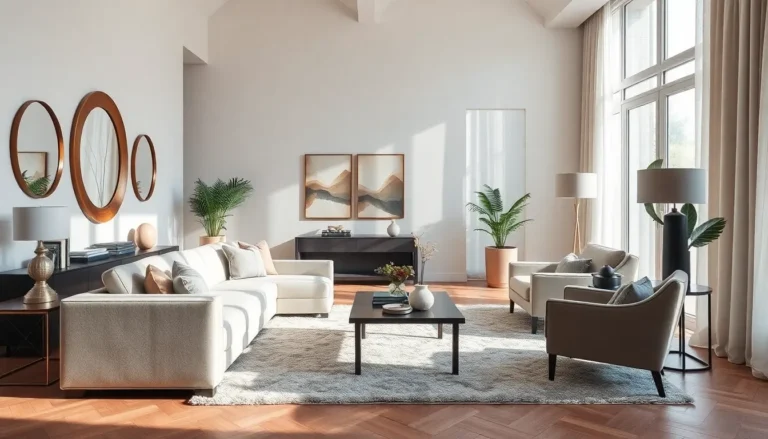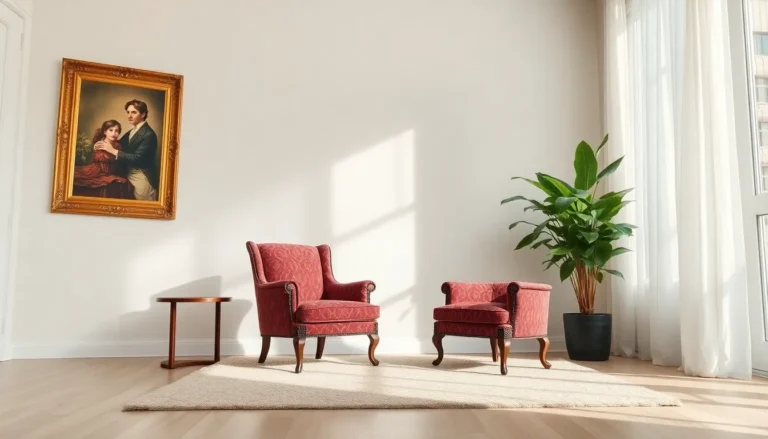Design isn’t just about making things pretty; it’s about how people think and feel. Enter design psychology, the secret sauce that turns ordinary spaces into experiences that make hearts race and minds engage. Ever wondered why you can’t resist that sleek gadget or why a cozy café feels like a warm hug? It’s all in the design choices that tap into human emotions and behaviors.
In a world overflowing with choices, understanding design psychology isn’t just a nice-to-have; it’s essential. It’s the difference between a website that gets ignored and one that keeps visitors coming back for more. By diving into the fascinating interplay of color, shape, and space, designers can create environments that not only attract attention but also inspire action. Buckle up as we explore the mind-bending world of design psychology and discover how it shapes our everyday experiences.
Table of Contents
ToggleUnderstanding Design Psychology
Design psychology plays a crucial role in crafting experiences that resonate with users. This discipline examines how design elements affect emotions and behaviors.
Definition of Design Psychology
Design psychology refers to the study of how various design aspects influence human perception and interaction. It encompasses elements like color, typography, layout, and symbolism. Designers leverage these components to shape user experiences and evoke specific feelings, guiding behavior through thoughtful choices.
Importance of Design Psychology in User Experience
Understanding design psychology enhances user experience significantly. Well-designed interfaces attract attention and foster deeper engagement. For instance, colors can evoke emotions, while shapes can convey meaning. Designers who grasp these principles create intuitive and enjoyable interactions, leading to higher satisfaction rates. Engaged users are more likely to return, ultimately driving success for brands and products. Recognizing this impact helps in making informed design decisions that cater to user needs effectively.
Key Principles of Design Psychology
Design psychology relies heavily on fundamental principles that shape how people interact with their environments. It examines essential elements that influence perceptions and experiences.
Cognitive Load and User Interaction
Cognitive load refers to the mental effort involved in processing information. Reducing cognitive load enhances user interaction and improves overall satisfaction. Designers often simplify layouts, using clear visual hierarchies to guide users. Intuitive navigation allows for fluid exploration, allowing users to find what they seek effortlessly. Well-structured designs free individuals from excessive mental strain, ensuring focus remains on important tasks. Implementing familiar patterns can further ease the cognitive load. This approach encourages faster decision-making, promoting user engagement and retention.
Color Psychology and Emotional Response
Color psychology plays a crucial role in evoking emotional responses. Different colors can stimulate feelings, influencing how users perceive a brand or product. Warm colors such as red and orange often generate energy and excitement, while cool colors like blue and green evoke calmness and peace. Designers deliberately select color palettes that resonate with target audiences to enhance brand messaging. Proper use of color not only attracts attention but also reinforces emotional connections. Thoughtfully applied colors guide user behavior, encouraging actions such as purchases or sign-ups. Understanding color’s psychological impact helps create meaningful interactions between users and designs.
Applications of Design Psychology
Design psychology finds practical applications in various fields, driving user engagement and satisfaction. It informs how individuals interact with products and digital platforms, enhancing overall experiences.
In Product Design
In product design, understanding how elements like color, shape, and texture affect emotions influences user loyalty. Designers create visually appealing products that connect emotionally with users, leading to positive perceptions. For instance, companies utilize materials and finishes to evoke feelings of quality and durability. Designers also pay attention to ergonomics, ensuring products fit naturally in users’ hands. This focus leads to a more intuitive experience, making products easy and enjoyable to use.
In Web and App Development
Web and app development relies heavily on design psychology to improve user interfaces. Engaging layouts and strategic color choices enhance the user experience. Designers create clear navigation paths, reducing cognitive load and enabling users to find information quickly. Features like ample white space and contrasting colors draw attention to important elements. User feedback guides refinements, ensuring applications remain intuitive and effective. Engaging visuals and user-friendly designs foster deeper connections, encouraging prolonged interactions with digital platforms.
Challenges in Design Psychology
Design psychology faces various challenges that impact its effectiveness. Addressing these challenges is crucial for creating engaging environments.
Misinterpretation of User Needs
Misunderstanding user needs often leads to ineffective designs. Designers may focus on their own preferences rather than understanding target audiences. This gap can result in products that fail to resonate emotionally. Surveys and user testing provide valuable insights into preferences and behaviors. Gathering this data before design decisions refines the process significantly. Ignoring diverse user feedback risks alienating potential customers, making it essential to integrate multiple perspectives and experiences.
Balancing Aesthetics and Functionality
Balancing aesthetics and functionality poses a significant challenge in design psychology. Stunning visuals may capture attention, but they shouldn’t compromise usability. Users often prioritize efficiency and ease of use over appearance. Designers must create visually appealing interfaces while ensuring intuitive navigation. Clear layouts and straightforward interactions enhance user satisfaction. Techniques like minimalism may help achieve this balance by reducing clutter without sacrificing style. Maintaining harmony between form and function ultimately leads to more successful designs that engage users effectively.
Design psychology plays a pivotal role in shaping user experiences across various platforms. By understanding how design elements influence emotions and behaviors, designers can create more engaging and intuitive environments. This knowledge not only enhances user satisfaction but also fosters brand loyalty.
As the digital landscape continues to evolve, the principles of design psychology remain essential for creating meaningful interactions. Designers who prioritize user insights and balance aesthetics with functionality will undoubtedly lead the way in crafting experiences that resonate deeply with audiences. Embracing these concepts will empower brands to stand out in a crowded marketplace and connect more effectively with their users.








